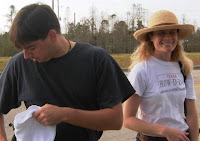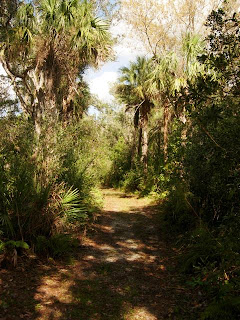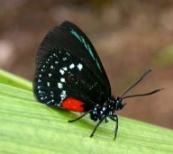January 2009
 I am excited to be starting in Manatee County by the end of January. This is a photo of one of the Preserves where I’ll be working, called Robinson Preserve. It even has a salt marsh, which is a quickly disappearing habitat in many locations in Florida. I'm looking forward to finding the Pygmy Blue butterfly, an imperiled species that uses salt marsh Glasswort as a host plant. I’ll be leading hiking, biking, canoeing, and kayaking tours, clearing out exotics, and planning and maintaining trails through the preserves. Hopefully, some of my east coast friends will be coming over to the left coast to enjoy this incredibly green environment!
I am excited to be starting in Manatee County by the end of January. This is a photo of one of the Preserves where I’ll be working, called Robinson Preserve. It even has a salt marsh, which is a quickly disappearing habitat in many locations in Florida. I'm looking forward to finding the Pygmy Blue butterfly, an imperiled species that uses salt marsh Glasswort as a host plant. I’ll be leading hiking, biking, canoeing, and kayaking tours, clearing out exotics, and planning and maintaining trails through the preserves. Hopefully, some of my east coast friends will be coming over to the left coast to enjoy this incredibly green environment!A Monarch Butterfly story: The pots in which I chose to plant milkweed for the Monarchs and Queens were great aesthetically, but I discovered that they were dangerous for the butterflies! When the caterpillars climbed down to pupate, they chose the lower lip because they couldn’t go anywhere else….it seemed like a great thing (I could keep track of the pupae and count them as they emerged)….but when the butterflies emerged, they tried to climb up so their wings could dry, and then they slipped on the smooth curved lip and fell wings-down to the ground! I lost a few because they emerged when I was not here to rescue them and of course I felt terrible about that happening.
 So to stop that from occurring again, as soon as I saw the cats wandering around the pots, I placed them inside my butterfly cage, where they crawled to the top and pupated safely. It seemed that the latest 'clutch' of Monarch caterpillars would be pupating while I was on the west coast, but perhaps because of the cold they
So to stop that from occurring again, as soon as I saw the cats wandering around the pots, I placed them inside my butterfly cage, where they crawled to the top and pupated safely. It seemed that the latest 'clutch' of Monarch caterpillars would be pupating while I was on the west coast, but perhaps because of the cold they  all emerged safely after I came back home. This is a photo of 11 of the 28 pupae in the cage, and another of a newly emerged Monarch amid the yet-to-emerge brethern. I had a little Monarch production line going this month!
all emerged safely after I came back home. This is a photo of 11 of the 28 pupae in the cage, and another of a newly emerged Monarch amid the yet-to-emerge brethern. I had a little Monarch production line going this month!Art Constantino is plant-sitting my milkweed for a while; he’s also propagating via the defoliated stems and returning some to me once I get settled into my new place in Bradenton. Some of the new plants generated will be donated to NABA meetings or plant sales.
 For those of you who don’t know, milkweed can be easily rooted in water and re-planted! This is what the defoliated stems look like after about a week in water…a whole new plant is created. I suspect that because the caterpillars cause complete destruction of the leaves, milkweed regenerates quickly!
For those of you who don’t know, milkweed can be easily rooted in water and re-planted! This is what the defoliated stems look like after about a week in water…a whole new plant is created. I suspect that because the caterpillars cause complete destruction of the leaves, milkweed regenerates quickly!The North American Butterfly Association (NABA) announces the release of its new butterfly gardening guide for south Florida. The south Florida garden guide promotes the use of regionally native plants when creating butterfly gardens. Information found in the south Florida garden guide encourages gardening practices that will increase the local population of butterflies while informing gardeners about the use of plants that promote healthy habitats. With the help of NABA members in south Florida, native butterfly garden plants are rated for their usefulness as nectar sources, caterpillar food sources, and overall garden worthiness. Future users of the south Florida garden guide can add to the knowledge base by submitting an online rating form for plants with which they have had experience. Check it out and give your feedback about the plants! It will help other gardeners choose plants for their gardens. Several of us in the Broward Chapter worked on this project, including myself and Art Constantino.
This is a photo of my great Broward County NABA butterfly friends at my "last" presentation on January 8. We had a super turn-out and everyone enjoyed the delicious cake after the meeting. Thanks to Art Constantino for remembering to bring a camera!

 Friends Kimberly and Tim and I traveled to Big Cypress
Friends Kimberly and Tim and I traveled to Big Cypress  for a day last month, too. This is inside the Panther Refuge; we didn’t see the cat, but we did see his paw prints!
for a day last month, too. This is inside the Panther Refuge; we didn’t see the cat, but we did see his paw prints!

 Friends Kimberly and Tim and I traveled to Big Cypress
Friends Kimberly and Tim and I traveled to Big Cypress  for a day last month, too. This is inside the Panther Refuge; we didn’t see the cat, but we did see his paw prints!
for a day last month, too. This is inside the Panther Refuge; we didn’t see the cat, but we did see his paw prints!We also saw this little sign for a "Gopher Tortoise Crossing" at another site that may have been used for a field education game...the little grasshopper using the sign as a perch caught my eye.


Atalas are recovering slowly at some sites in Fort Lauderdale, but Miami-Dade is reporting very few eggs or larvae. But, at least one site in Miami-Dade has witnessed quite a few adults nectaring on Jack-in-the-Bush, sometimes called Frostweed (Chromolaena odorata). Caterpillars and eggs were not found, but this is evidence that the colonies will be recovering soon. Thanks to Rusty Pfost for the updates and photo.


The January 10, 2009 Exotic Plant Removal/Identification Workshop at John Williams Park/Sheridan Oak Forest was the last one that I will be leading, but volunteers Lisa Cook and her daughter Jessica will be leading monthly workshops until summer. This is a great opportunity to get community service hours and make a difference in this beautiful oak hammock.  We saw this gorgeous Silver Argiope spider (Argiope argentata). She is another new species for the park! We had a very productive day with seven volunteers, including two friends (thanks, Marianna and Sheryl!) from the North American Butterfly Association. Keep a watch on the City of Hollywood’s website for news about future workshops. Once you come to a workshop, your email address will keep you informed about upcoming projects in the parks. And anyone who attends the exotic plant removal and identification workshops will receive a free Native/Non-Native identification booklet that I designed especially for John Williams Park.
We saw this gorgeous Silver Argiope spider (Argiope argentata). She is another new species for the park! We had a very productive day with seven volunteers, including two friends (thanks, Marianna and Sheryl!) from the North American Butterfly Association. Keep a watch on the City of Hollywood’s website for news about future workshops. Once you come to a workshop, your email address will keep you informed about upcoming projects in the parks. And anyone who attends the exotic plant removal and identification workshops will receive a free Native/Non-Native identification booklet that I designed especially for John Williams Park.
 We saw this gorgeous Silver Argiope spider (Argiope argentata). She is another new species for the park! We had a very productive day with seven volunteers, including two friends (thanks, Marianna and Sheryl!) from the North American Butterfly Association. Keep a watch on the City of Hollywood’s website for news about future workshops. Once you come to a workshop, your email address will keep you informed about upcoming projects in the parks. And anyone who attends the exotic plant removal and identification workshops will receive a free Native/Non-Native identification booklet that I designed especially for John Williams Park.
We saw this gorgeous Silver Argiope spider (Argiope argentata). She is another new species for the park! We had a very productive day with seven volunteers, including two friends (thanks, Marianna and Sheryl!) from the North American Butterfly Association. Keep a watch on the City of Hollywood’s website for news about future workshops. Once you come to a workshop, your email address will keep you informed about upcoming projects in the parks. And anyone who attends the exotic plant removal and identification workshops will receive a free Native/Non-Native identification booklet that I designed especially for John Williams Park. "Today I have grown taller from walking with the the trees." --Karle Baker Wilson.
Labels: atala butterflies, John Williams Park, Manatee County, milkweed



1 Comments:
Hi Sandy - it's Christy from EDS. I just happened upon your blog while searching for info about John Williams park in Hollywood. I'd like to take my nature class there. Too bad you won't be around - but congrats on your new job, sounds exciting. Your blog is great. Check out mine about nature classes with kids:
thenatureteacher.blogspot.com
Post a Comment
<< Home